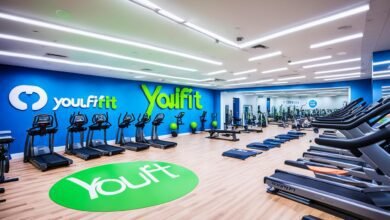The Ultimate Guide to Creating a Sustainable Fitness Routine

In a world where the pursuit of health and wellness is becoming increasingly important, creating a sustainable fitness routine has never been more crucial. A sustainable fitness routine is one that you can stick with over the long term, ensuring that you not only reach your fitness goals but maintain them. Whether you’re a beginner or an experienced fitness enthusiast, this comprehensive guide will help you create a fitness routine that’s not only effective but also sustainable.
1. Introduction
In a world where sedentary lifestyles are on the rise, and the allure of quick-fix fitness fads is ever-present, creating a sustainable fitness routine is the key to achieving long-term health and wellness. A sustainable fitness routine is one that you can maintain not just for weeks or months, but for years and even a lifetime. In this guide, we will explore the importance of sustainability and the steps to create a fitness routine that not only gets you in shape but keeps you in shape.
2. Understanding the Importance of Sustainability
Before diving into the practical aspects of creating a sustainable fitness routine, it’s essential to understand why sustainability is crucial. Many people embark on fitness journeys with zeal, only to lose motivation and fall back into their old habits. This happens because their initial approach was not sustainable. Here’s why sustainability is important:
Long-term Results
Sustainability ensures that the results you achieve are not short-lived. It’s about making lifestyle changes that lead to lasting improvements in your health and fitness.
Reduced Risk of Burnout
Fitness should not be an all-or-nothing endeavor. Unsustainable routines often lead to burnout, as they are too demanding to maintain over time. A sustainable routine can prevent this.
Improved Overall Well-being
A fitness routine that you can stick to over the long term contributes to your overall well-being. It can boost your mental health, increase your energy levels, and enhance your quality of life.
Consistent Progress
Sustainable routines allow for consistent progress. You’ll be more likely to achieve your fitness goals by maintaining a routine that you can follow through with.
3. Setting Clear and Achievable Goals
The first step in creating a sustainable fitness routine is setting clear and achievable goals. Your goals provide direction and motivation for your fitness journey. Here’s how to set effective fitness goals:
S.M.A.R.T. Goals
S.M.A.R.T. stands for Specific, Measurable, Achievable, Relevant, and Time-bound. Your fitness goals should meet these criteria. For example, instead of saying, “I want to lose weight,” you could say, “I want to lose 10 pounds in the next three months by following a balanced diet and exercising three times a week.”
Short-term and Long-term Goals
Set both short-term and long-term goals. Short-term goals help you stay motivated, while long-term goals provide a sense of purpose. Short-term goals could include losing a few pounds in a month, while long-term goals might involve running a marathon within a year.
Celebrate Milestones
As you achieve your goals, celebrate your milestones. Recognizing your progress will motivate you to keep going. It could be as simple as treating yourself to a new workout outfit or enjoying a cheat meal.
4. Choosing the Right Activities
The next step is to choose the right activities for your fitness routine. The activities you select should align with your goals and personal preferences. Here are some considerations when choosing fitness activities:
Interest and Enjoyment
Select activities that you genuinely enjoy. If you love what you’re doing, you’re more likely to stick with it. This could be anything from dancing to swimming to weightlifting.
Variety
Incorporate variety into your routine to prevent boredom and overuse injuries. Try a mix of cardiovascular exercises, strength training, flexibility work, and sports or recreational activities.
Accessibility
Consider the accessibility of your chosen activities. Do you have access to a gym, or do you prefer home workouts? Can you easily access the equipment and facilities you need?
Skill Level
Choose activities that match your current skill level. If you’re a beginner, start with beginner-friendly workouts. As you progress, you can gradually challenge yourself with more advanced exercises.
5. Structuring Your Fitness Routine
Now that you have a clear understanding of your goals and have chosen suitable activities, it’s time to structure your fitness routine. A well-structured routine ensures that you are getting a balanced workout. Here’s how to do it:
Frequency
Determine how often you’ll work out. The frequency depends on your goals, but for general fitness, aim for at least three to five sessions per week. Make sure to include rest days to allow your body to recover.
Duration
Decide how long each workout will be. Typically, a workout session can last anywhere from 30 minutes to an hour, depending on your schedule and fitness level.
Timing
Consider the best time of day for your workouts. Some people prefer morning workouts to kickstart their day, while others find it more convenient to exercise in the evening. Choose a time that suits your lifestyle.
Consistency
Consistency is key to sustainability. Create a weekly schedule that you can stick to and make exercise a non-negotiable part of your routine.
Set Clear Goals
The first step in structuring your fitness routine is setting clear and achievable goals. These goals can vary from weight loss and muscle gain to improving cardiovascular health and increasing flexibility. Having specific goals helps you stay motivated and focused on your fitness journey. Make your goals measurable and time-bound, such as losing 10 pounds in three months or running a 5k in eight weeks.
Choose the Right Exercises
Selecting the right exercises that align with your goals is crucial. Your fitness routine should include a combination of cardiovascular exercises, strength training, and flexibility workouts. For weight loss, activities like running, cycling, or swimming can be effective, while strength training is essential for muscle gain. Incorporating yoga or stretching routines can enhance flexibility and reduce the risk of injuries.
6. Balancing Cardiovascular and Strength Training

A sustainable fitness routine should strike a balance between cardiovascular exercises and strength training. Both types of exercise offer unique benefits:
Cardiovascular Exercises
Cardiovascular exercises, like running, cycling, and swimming, improve your cardiovascular health, help burn calories, and increase your endurance. Aim for at least 150 minutes of moderate-intensity or 75 minutes of vigorous-intensity cardio each week.
Strength Training
Strength training, which includes weightlifting and bodyweight exercises, builds lean muscle mass, boosts your metabolism, and enhances your strength. Incorporate strength training at least two to three times a week, targeting different muscle groups.
Full-Body Workouts
Consider full-body workouts that combine both cardio and strength elements. Examples include circuit training and high-intensity interval training (HIIT), which provide a comprehensive fitness experience.
7. The Role of Nutrition
Nutrition plays a crucial role in creating a sustainable fitness routine. Your eating habits can significantly impact your energy levels, recovery, and overall progress. Here are some guidelines for a balanced diet:
Balanced Diet
Consume a balanced diet that includes a variety of fruits, vegetables, lean proteins, whole grains, and healthy fats. Avoid highly processed foods and excessive sugar and saturated fat.
Portion Control
Practice portion control to manage your calorie intake. Eating in moderation can help you maintain a healthy weight and prevent overeating.
Stay Hydrated
Proper hydration is essential for performance and recovery. Drink enough water throughout the day, especially before, during, and after your workouts.
Timing Matters
Consider the timing of your meals and snacks. Eating a balanced meal 1-2 hours before a workout can provide you with the necessary energy. After your workout, refuel with a combination of protein and carbohydrates to aid recovery.
Listen to Your Body
Pay attention to your body’s hunger and fullness cues. Eating mindfully can help you avoid emotional eating and unnecessary snacking.
8. The Importance of Rest and Recovery
Rest and recovery are often overlooked in fitness routines, but they are crucial for sustainability and progress. Here’s why they matter:
Prevent Overtraining
Overtraining can lead to burnout and injury. Rest days allow your body to recover and repair, reducing the risk of overtraining.
Sleep
Adequate sleep is essential for your physical and mental well-being. Aim for 7-9 hours of quality sleep per night to support your workouts and overall health.
Active Recovery
On rest days, consider active recovery activities like yoga, stretching, or a leisurely walk. These can help maintain flexibility and reduce muscle soreness.
Listen to Your Body
If you feel fatigued or notice signs of overtraining, don’t hesitate to take an extra rest day. Your body’s signals are essential for long-term sustainability.
9. Staying Consistent and Motivated

Consistency and motivation go hand in hand in maintaining a sustainable fitness routine. Here are some strategies to help you stay on track:
Find a Workout Buddy
Exercising with a friend or partner can make workouts more enjoyable and hold you accountable.
Set Rewards
Reward yourself when you achieve milestones or stick to your routine. Rewards can serve as powerful motivators.
Track Your Progress
Keep a fitness journal to track your progress. Documenting your achievements can boost your motivation.
Join a Fitness Community
Being part of a fitness community, whether in person or online, can provide support, encouragement, and inspiration.
Mix Things Up
Introduce variety into your routine by trying new activities or workouts. This can prevent boredom and keep things exciting.
10. Overcoming Common Challenges
On your journey to a sustainable fitness routine, you may encounter common challenges that can test your commitment. Here’s how to overcome them:
Time Constraints
If time is a constraint, look for ways to incorporate short, effective workouts into your day. High-intensity interval training (HIIT) can be a time-efficient option.
Lack of Motivation
If you’re struggling with motivation, remind yourself of your goals and the reasons you started your fitness journey. Adjust your goals if needed to reignite your passion.
Plateaus
Plateaus are common, but they can be frustrating. If you hit a plateau, consider changing your routine, increasing intensity, or seeking guidance from a fitness professional.
Injuries
Injuries can be setbacks, but they don’t have to derail your fitness journey. Focus on recovery, consult a healthcare professional, and explore safe exercise alternatives.
Life Events
Life events, such as a busy work schedule or family responsibilities, can disrupt your routine. Be adaptable and find ways to integrate fitness into your life during such periods.
11. Adapting to Life Changes
Life is constantly changing, and your fitness routine should adapt accordingly. Whether you’re facing new challenges or opportunities, here’s how to keep your routine sustainable:
Plan Ahead
Anticipate changes in your schedule and plan your workouts accordingly. This may involve adjusting your workout times or changing your routine.
Be Flexible
Flexibility is key to sustainability. If you can’t stick to your usual workout, be open to trying different activities or adapting your fitness plan.
Seek Support
Share your fitness goals and challenges with friends and family. They can provide support and help you stay on track during life changes.
Prioritize Self-Care
Remember that self-care is essential. Make time for your health, even when life gets hectic. It’s an investment in your well-being.
Reassess Your Goals
Life changes may prompt you to reassess your fitness goals. Adjust your goals as needed to ensure they align with your current circumstances.
12. Conclusion
Creating a sustainable fitness routine is a holistic process that involves setting clear goals, choosing the right activities, structuring your routine, balancing cardiovascular and strength training, focusing on nutrition, prioritizing rest and recovery, staying consistent, and overcoming common challenges. As you embark on your fitness journey, remember that sustainability is the key to long-term success.
By understanding the importance of sustainability and following the principles outlined in this guide, you can build a fitness routine that not only helps you achieve your goals but also maintains your health and well-being over the years. Whether you’re a beginner or a seasoned fitness enthusiast, a sustainable fitness routine is within your reach, and the benefits it offers are immeasurable. So, start today and embark on your path to a healthier, happier, and more sustainable fitness journey.




